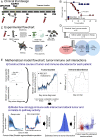Circulating immune cell phenotype dynamics reflect the strength of tumor-immune cell interactions in patients during immunotherapy
- PMID: 32571915
- PMCID: PMC7355015
- DOI: 10.1073/pnas.1918937117
Circulating immune cell phenotype dynamics reflect the strength of tumor-immune cell interactions in patients during immunotherapy
Abstract
The extent to which immune cell phenotypes in the peripheral blood reflect within-tumor immune activity prior to and early in cancer therapy is unclear. To address this question, we studied the population dynamics of tumor and immune cells, and immune phenotypic changes, using clinical tumor and immune cell measurements and single-cell genomic analyses. These samples were serially obtained from a cohort of advanced gastrointestinal cancer patients enrolled in a trial with chemotherapy and immunotherapy. Using an ecological population model, fitted to clinical tumor burden and immune cell abundance data from each patient, we find evidence of a strong tumor-circulating immune cell interaction in responder patients but not in those patients that progress on treatment. Upon initiation of therapy, immune cell abundance increased rapidly in responsive patients, and once the peak level is reached tumor burden decreases, similar to models of predator-prey interactions; these dynamic patterns were absent in nonresponder patients. To interrogate phenotype dynamics of circulating immune cells, we performed single-cell RNA sequencing at serial time points during treatment. These data show that peripheral immune cell phenotypes were linked to the increased strength of patients' tumor-immune cell interaction, including increased cytotoxic differentiation and strong activation of interferon signaling in peripheral T cells in responder patients. Joint modeling of clinical and genomic data highlights the interactions between tumor and immune cell populations and reveals how variation in patient responsiveness can be explained by differences in peripheral immune cell signaling and differentiation soon after the initiation of immunotherapy.
Keywords: cancer; ecological models; immunotherapy; phenotypes; single-cell RNA sequencing.
Conflict of interest statement
Competing interest statement: S.S. reports clinical trial funding from Merck for this study, which did not support the research in this paper; clinical research funding from Novartis, GSK, Millennium, MedImmune, Johnson & Johnson, Gilead Sciences, Plexxikon, Onyx, Bayer, Blueprint Medicines, XuanZhu, Incyte, Toray Industries, Celgene, Hengrui Therapeutics, OncoMed, Tesaro, AADi, and Syndax outside the submitted work; equity from Salarius Pharmaceuticals, Iterion Therapeutics, Proterus Therapeutics, ConverGene, and Stingray Therapeutics outside the submitted work; and honoraria from Blend Therapeutics, Foundation Medicine, Guardant Health, Novartis, ARIAD, US Oncology, Exelixis, Genesis Biotechnology Group, LSK, Natera, Loxo Oncology, Hengrui Therapeutics, Tarveda Therapeutics, and Dracen Pharmaceuticals outside the submitted work. D.S. reports grants from Novartis, BMS, Bioverativ, and AstraZeneca outside the submitted work and personal fees from Salarius Pharmaceuticals, Iterion Therapeutics, GlycosBio, and BMS outside the submitted work.
Figures





References
Publication types
MeSH terms
Substances
Grants and funding
LinkOut - more resources
Full Text Sources
Other Literature Sources
Medical
Molecular Biology Databases

